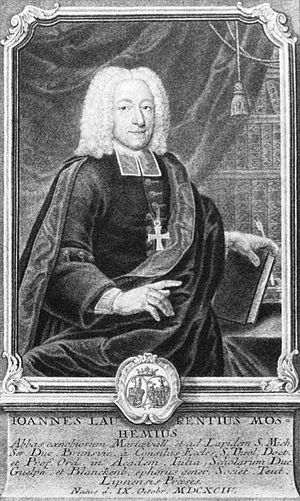Johann Lorenz von Mosheim facts for kids
Johann Lorenz von Mosheim (born October 9, 1693 – died September 9, 1755) was an important German Lutheran church historian. He spent his life studying and writing about the history of the Christian church.
Contents
Early Life and Education
Johann Lorenz von Mosheim was born in Lübeck, Germany, on October 9, 1693. He started his education at the gymnasium in Lübeck. Later, in 1716, he went to the University of Kiel. He earned his master's degree there in 1718. By 1719, he became an assessor, which is like a junior professor, in the philosophy department at Kiel.
A Growing Career
Mosheim first became known for his writings in 1720. He wrote a paper called Vindiciae antiquae christianorum disciplinae. This was followed by another work, Observationes sacrae, in 1721. Because of these writings and his reputation as a great lecturer and preacher, he was invited to teach at the University of Helmstedt. He became a full professor there in 1723.
In 1726, he published a major work called Institutiones Historiae Ecclesiasticae Novi Testamenti. In the same year, the Duke of Brunswick made him the abbot of Marienthal Abbey. An abbot is the head of a monastery. The next year, he also became the abbot of Michaelstein Abbey.
University Leadership
Mosheim played a big role when the new University of Göttingen was being set up. Leaders often asked for his advice, especially about how the theology department should work. He helped make sure that theologians could make their own decisions without too much interference from church courts.
In 1747, he became the chancellor of the university. This was a very high leadership position. The next year, in 1748, he was in charge when George II of Great Britain visited the university. Johann Lorenz von Mosheim passed away in Göttingen on September 9, 1755.
Important Writings
Mosheim wrote many important books during his life. One of his key works was De rebus christianorum ante Constantinum commentarii (1753). He also wrote Ketzer-Geschichte (a second edition came out in 1748) and Sittenlehre der heiligen Schrift (1737).
His writings about the Bible were known for being smart and well-researched. These included Cogitationes in N. T. bc. select. (1726). He also wrote detailed explanations of parts of the Bible, like the First Letter to the Corinthians (1741) and the two Letters to Timothy (1755).
Mosheim was also a skilled speaker. His sermons, called Heilige Reden, showed his talent for speaking and writing. His work, especially his Ecclesiastical History, was very important. It was a key source for Edward Gibbon's famous book, The History of the Decline and Fall of the Roman Empire. Gibbon used many of Mosheim's ideas in his own work.
See also
- Great Apostasy
- Giulio Lorenzo Selvaggio
- Town of Mosheim, Tennessee


